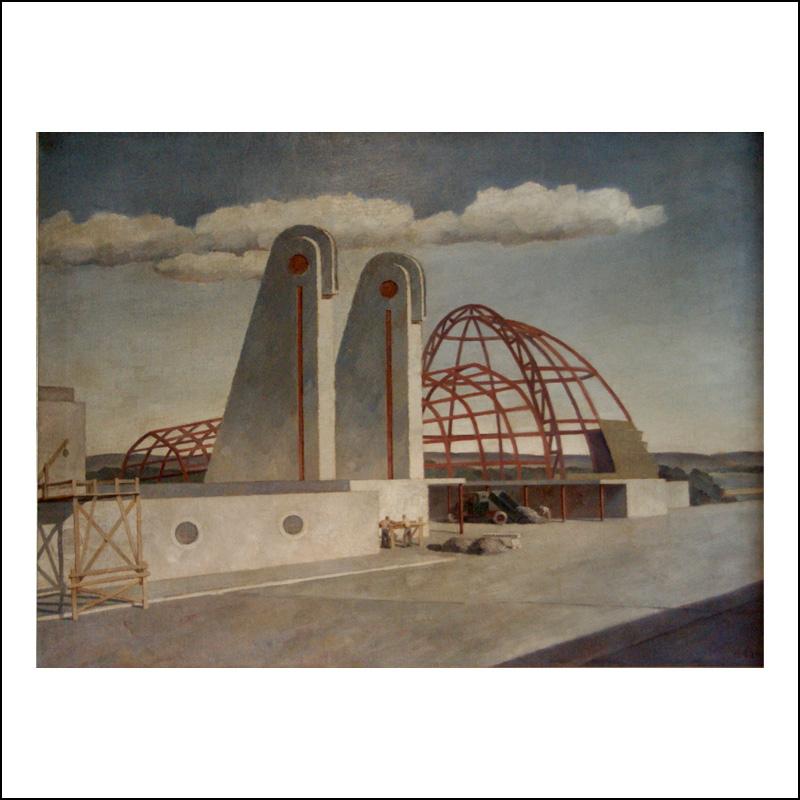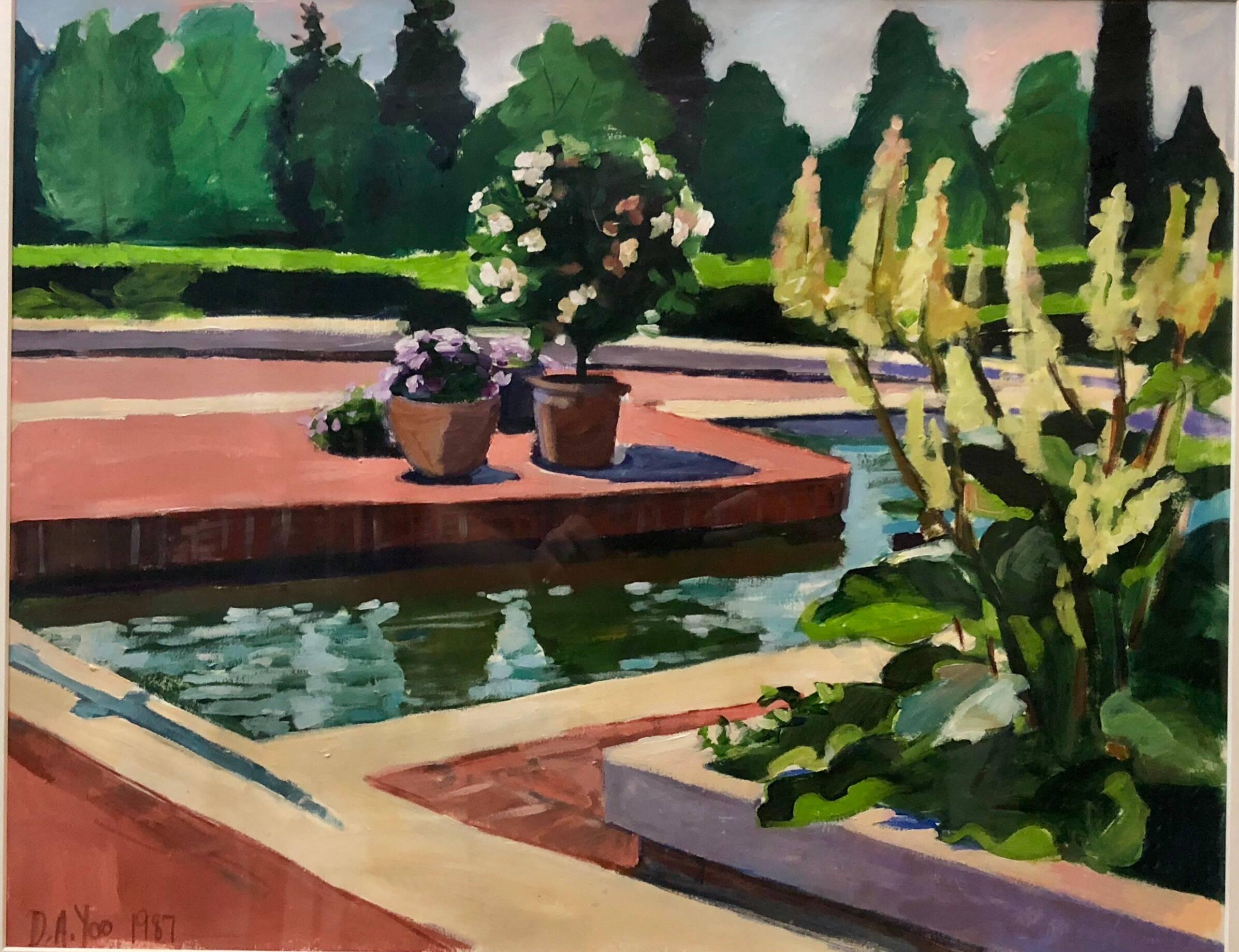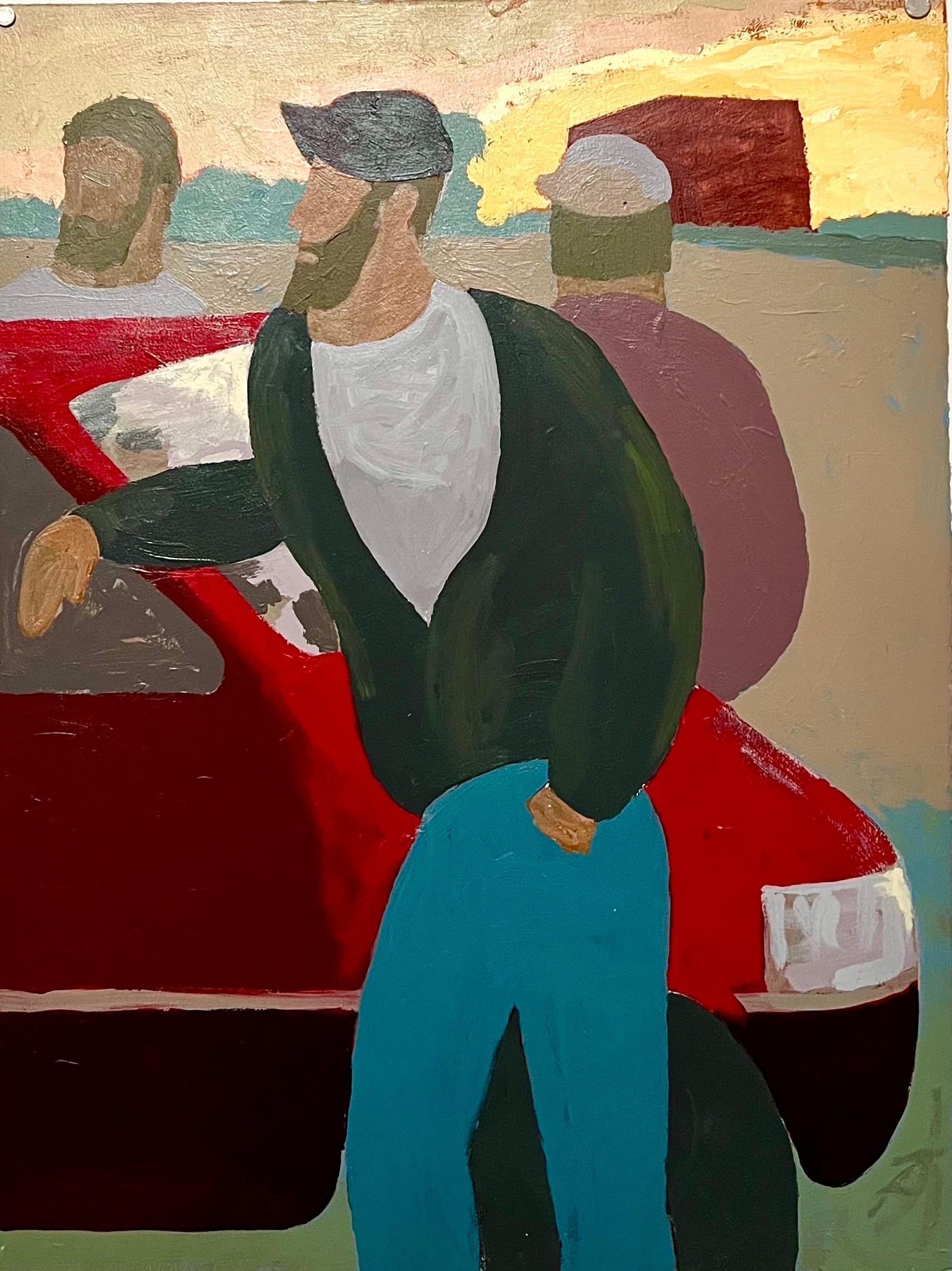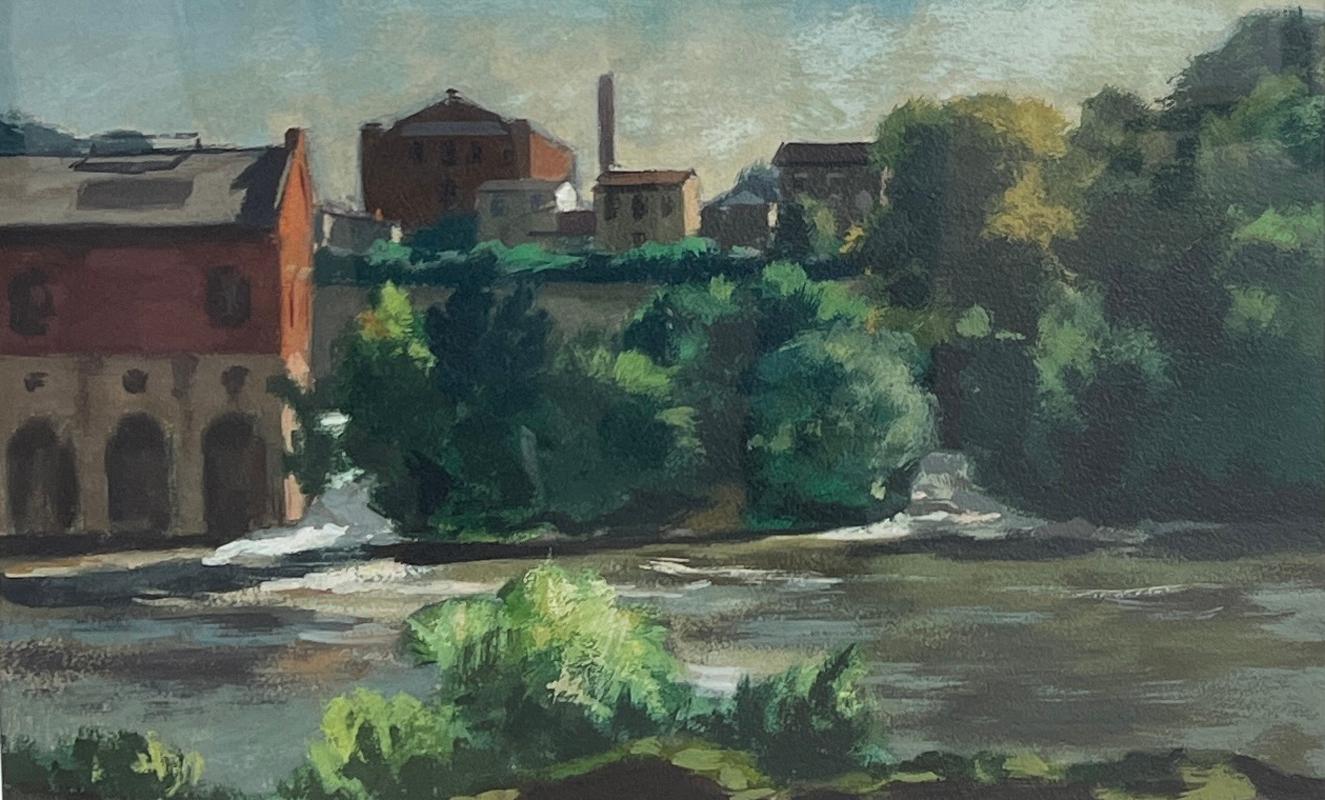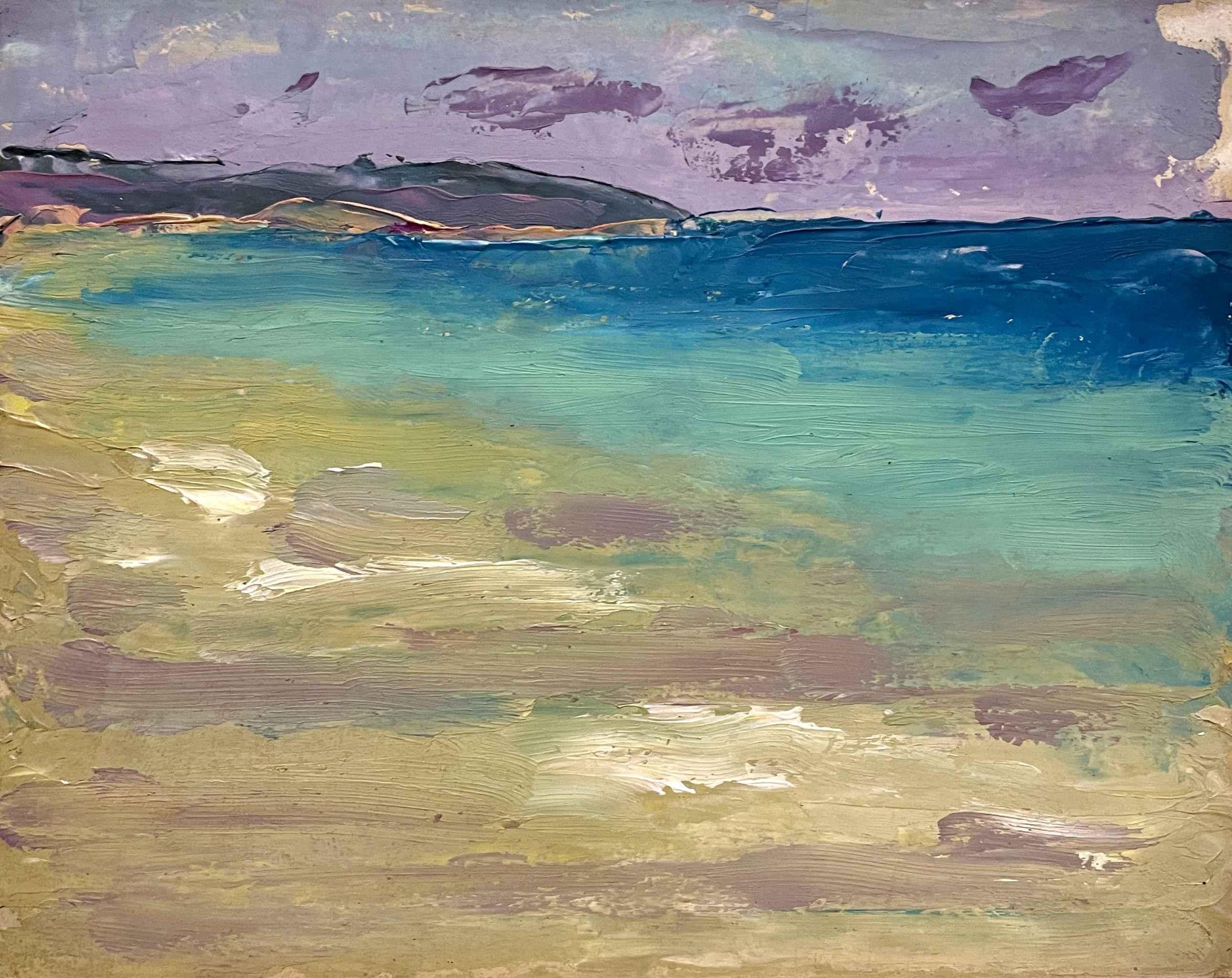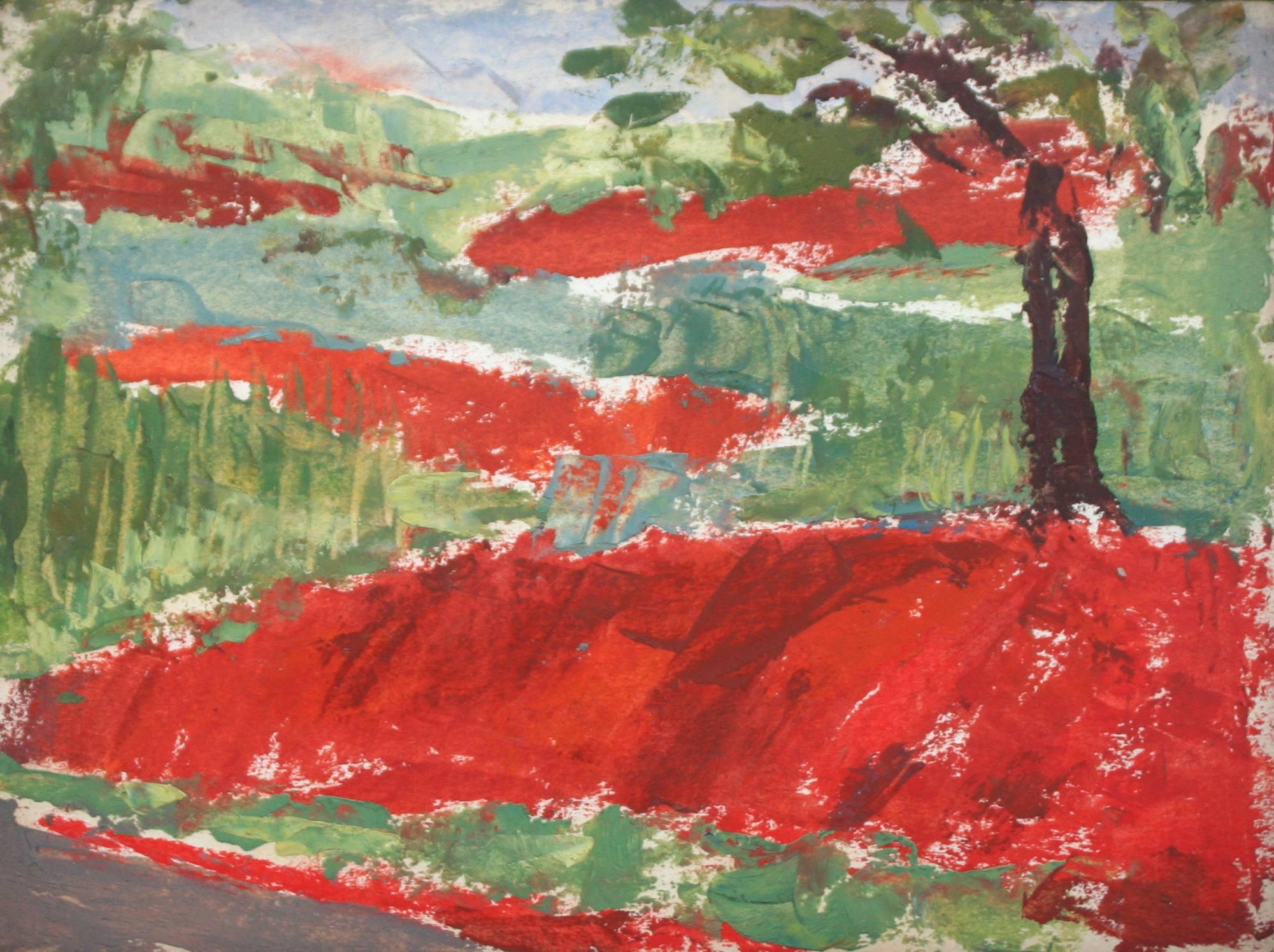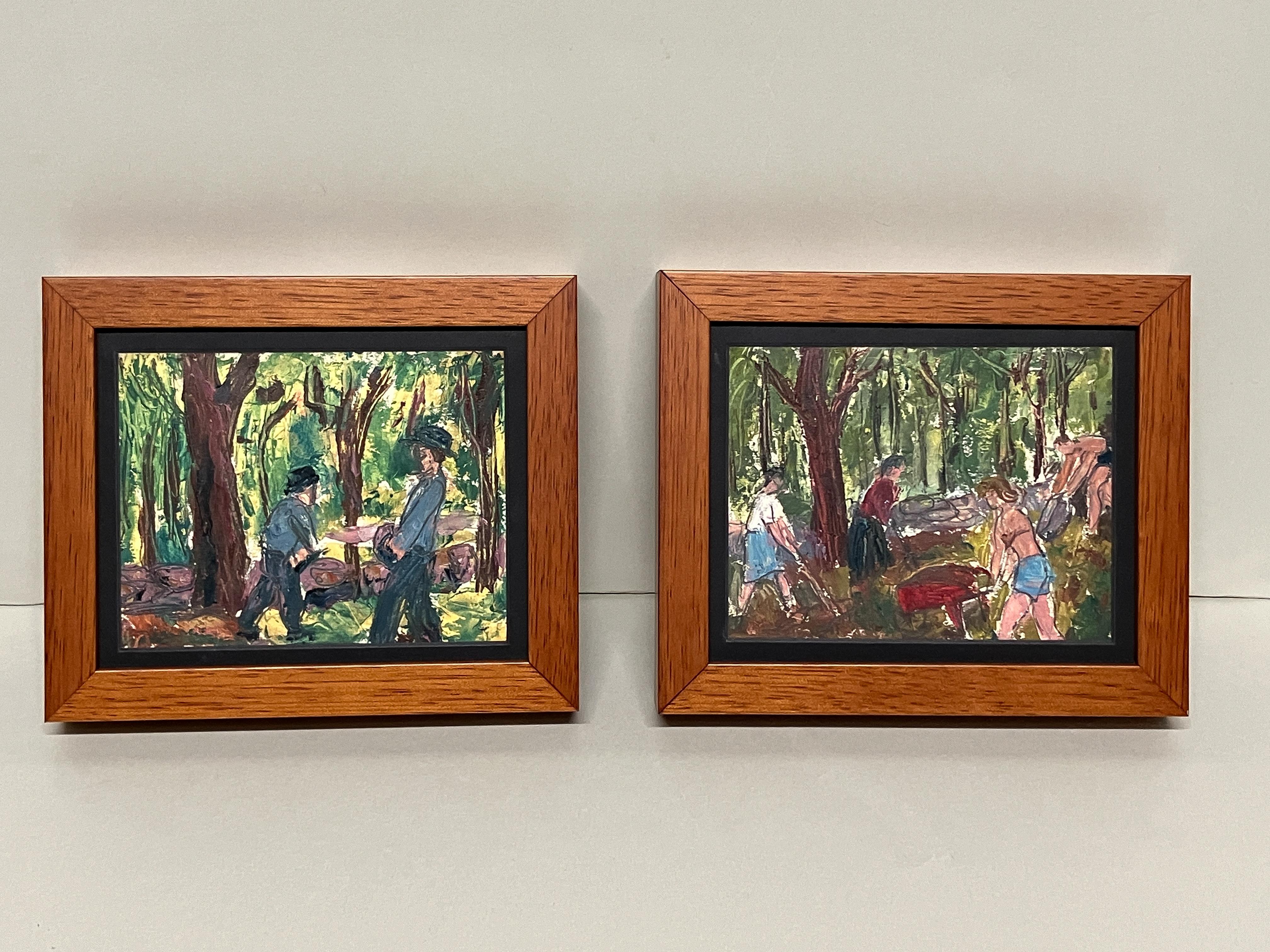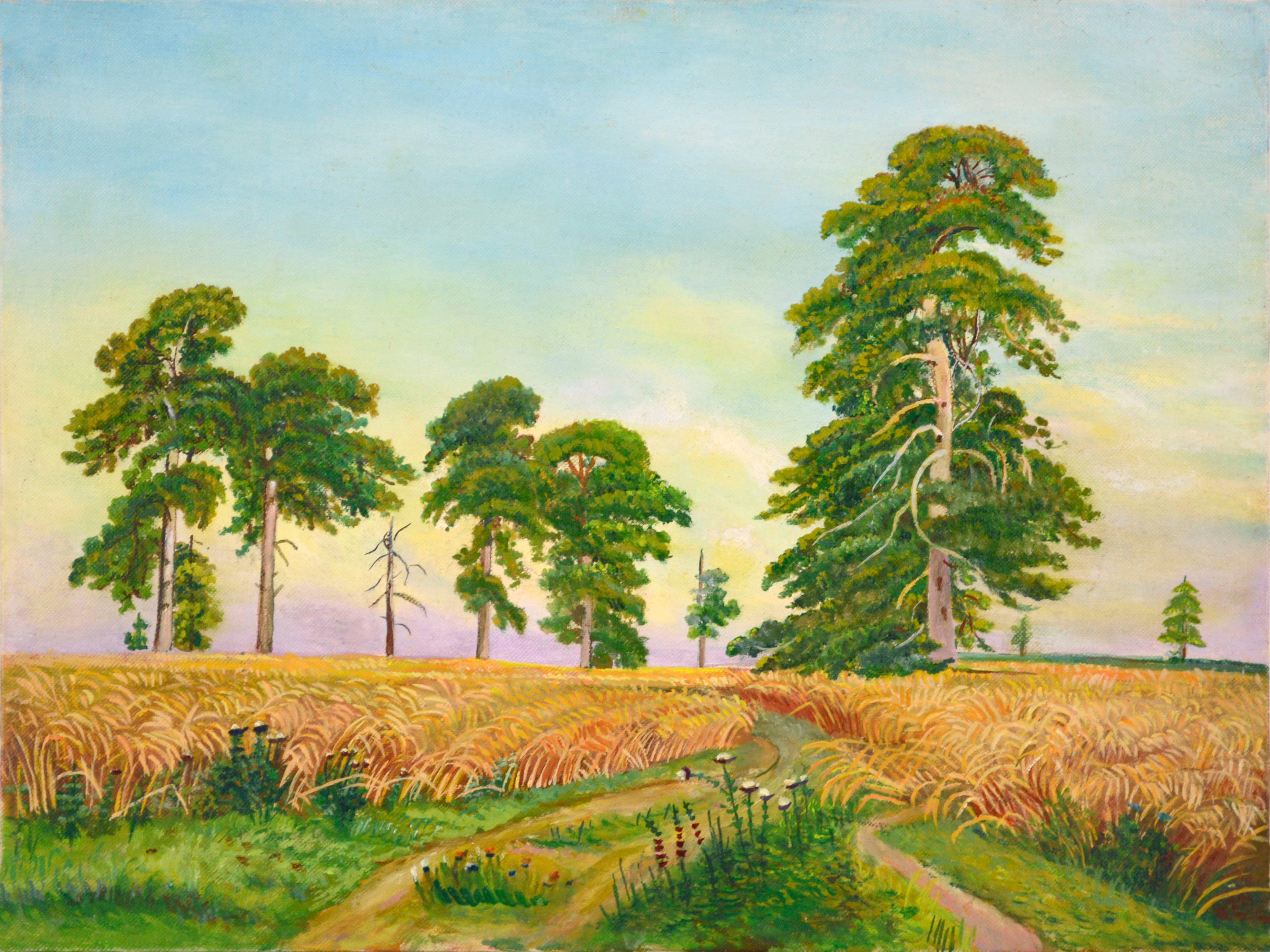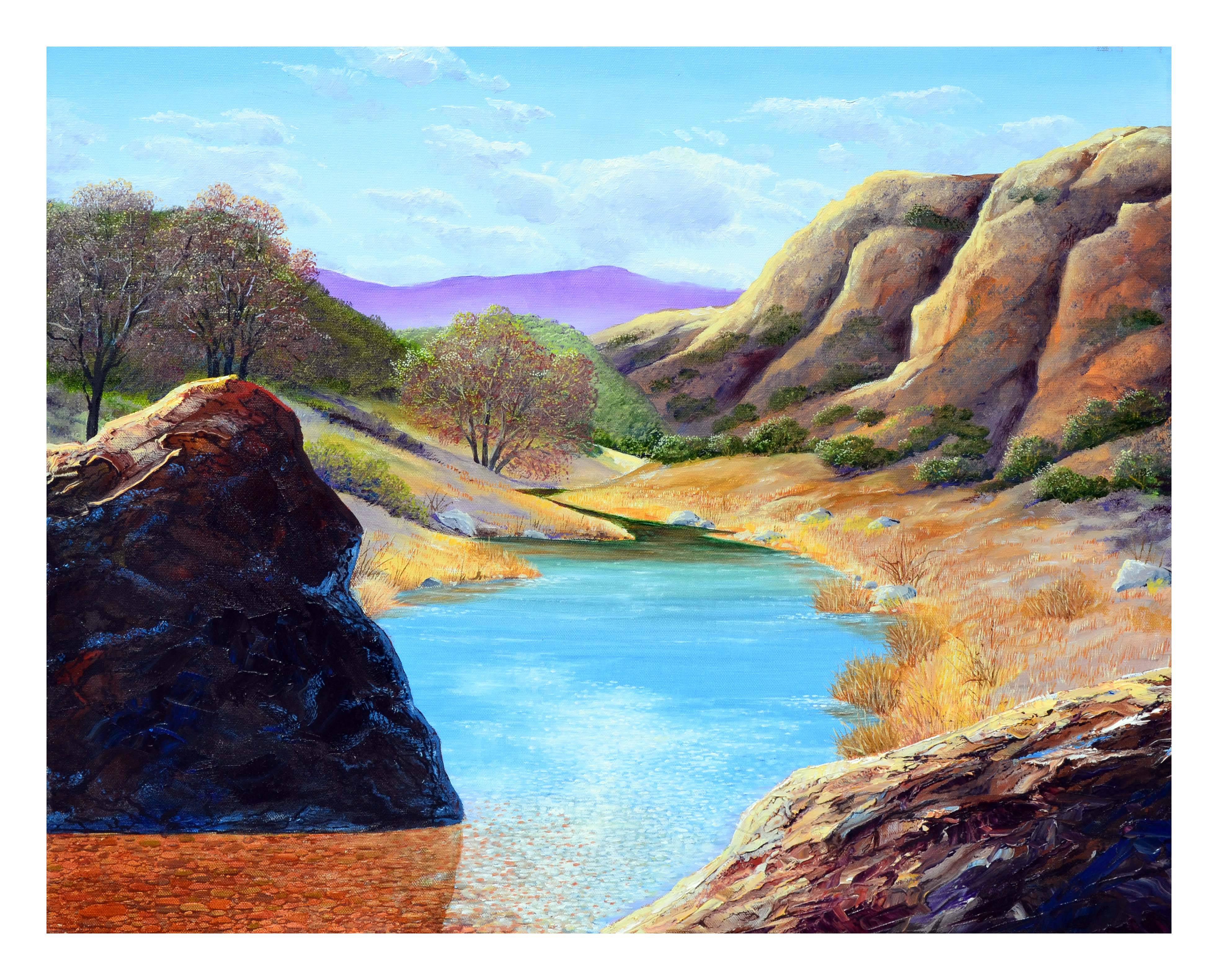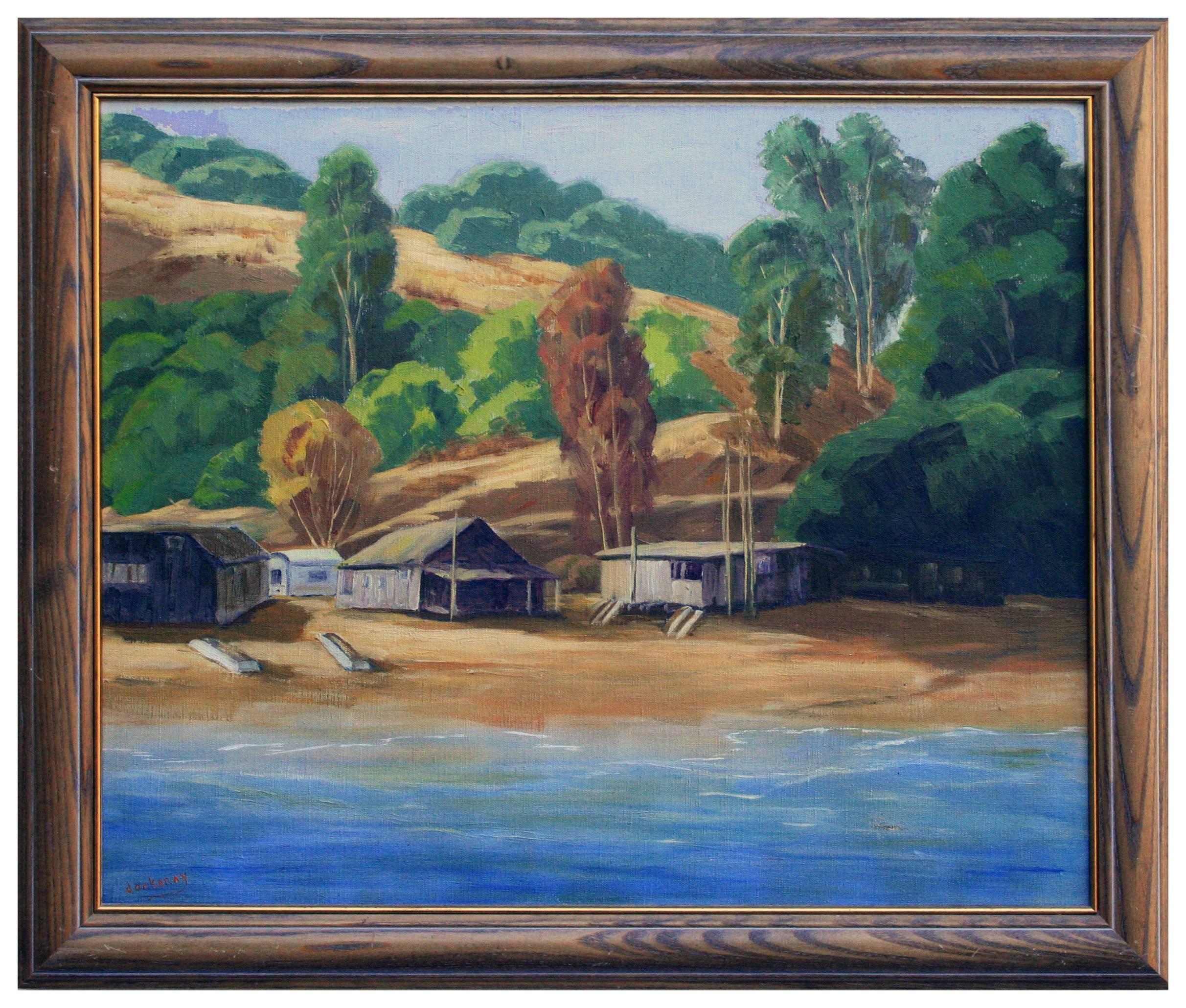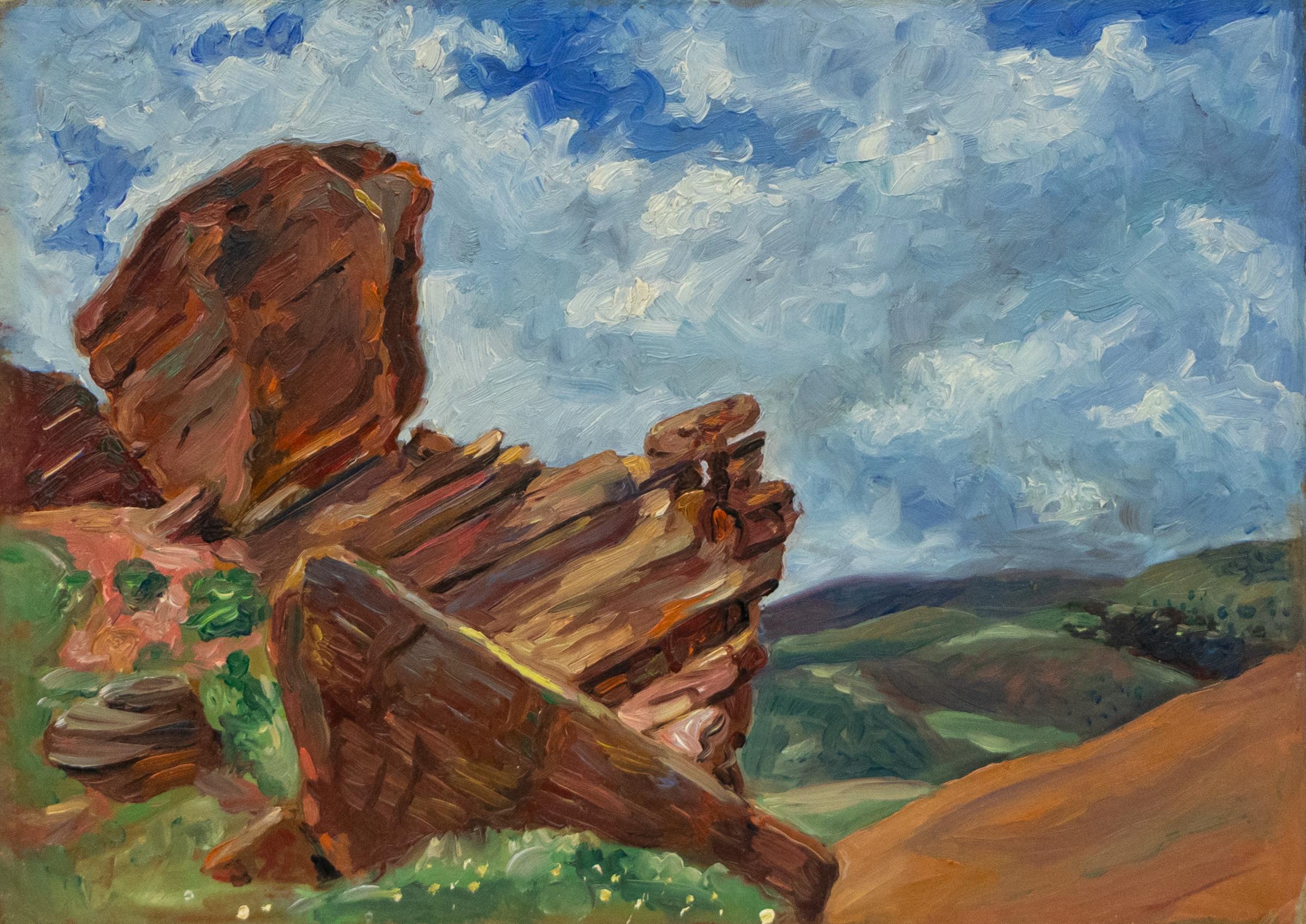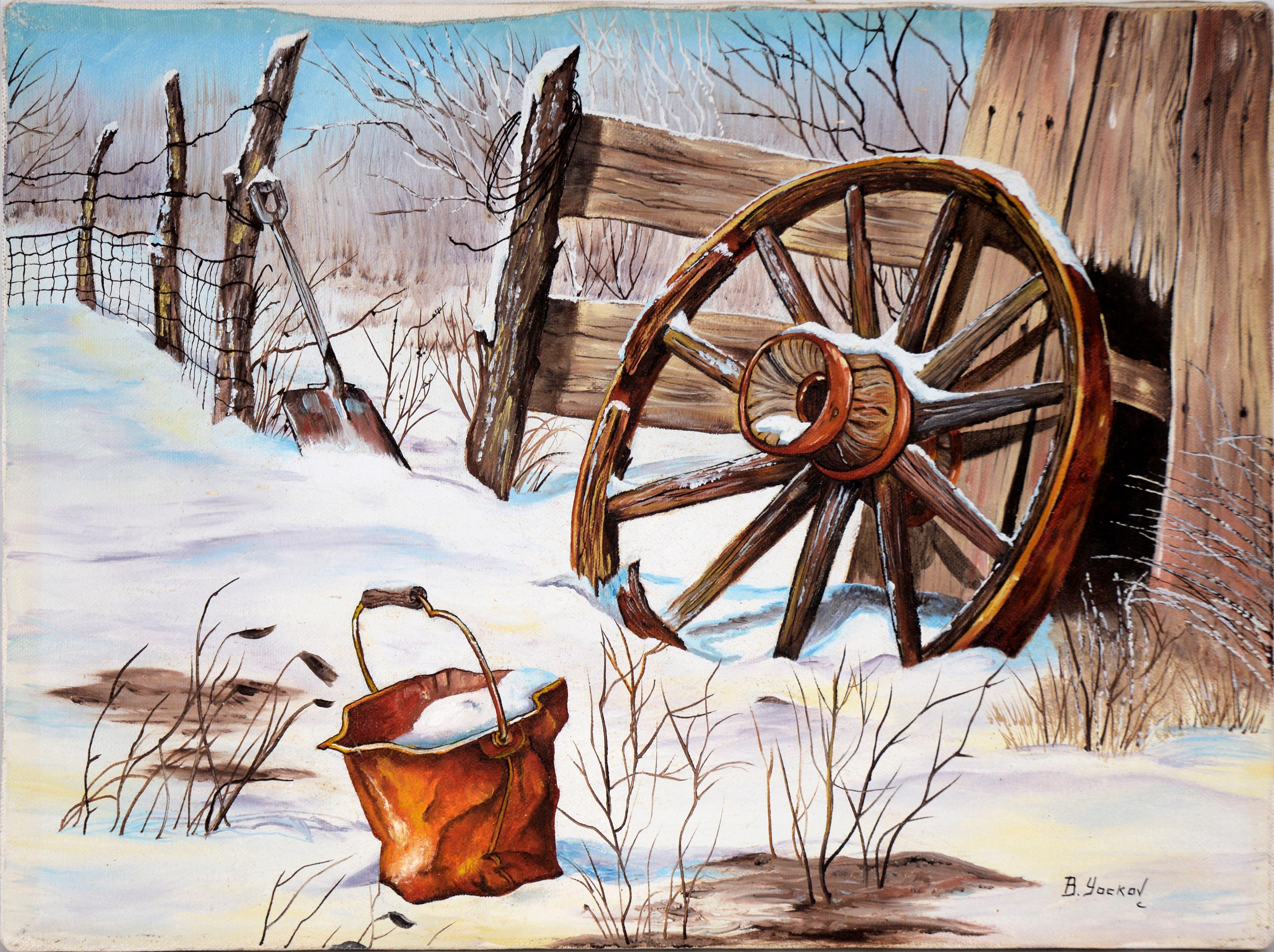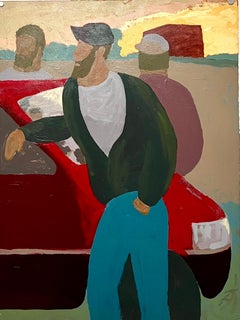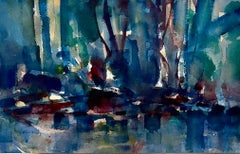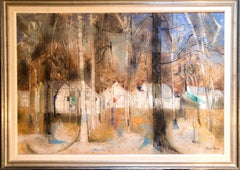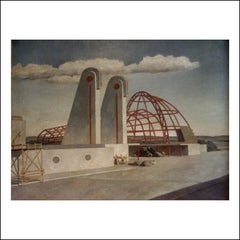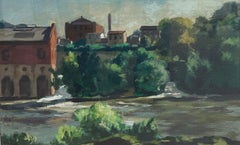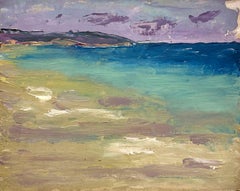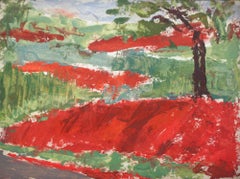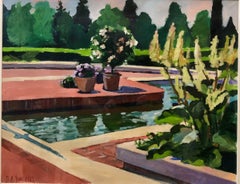
Botanic Garden II, Modernist Oil Painting Pool With Flowers and Garden
View Similar Items
Want more images or videos?
Request additional images or videos from the seller
1 of 7
Debra YooBotanic Garden II, Modernist Oil Painting Pool With Flowers and Garden1987
1987
About the Item
- Creator:Debra Yoo (American)
- Creation Year:1987
- Dimensions:Height: 27 in (68.58 cm)Width: 33 in (83.82 cm)
- Medium:
- Movement & Style:
- Period:
- Condition:no glass.
- Gallery Location:Surfside, FL
- Reference Number:1stDibs: LU3822559151
About the Seller
4.9
Platinum Seller
Premium sellers with a 4.7+ rating and 24-hour response times
Established in 1995
1stDibs seller since 2014
1,760 sales on 1stDibs
Typical response time: 1 hour
Authenticity Guarantee
In the unlikely event there’s an issue with an item’s authenticity, contact us within 1 year for a full refund. DetailsMoney-Back Guarantee
If your item is not as described, is damaged in transit, or does not arrive, contact us within 7 days for a full refund. Details24-Hour Cancellation
You have a 24-hour grace period in which to reconsider your purchase, with no questions asked.Vetted Professional Sellers
Our world-class sellers must adhere to strict standards for service and quality, maintaining the integrity of our listings.Price-Match Guarantee
If you find that a seller listed the same item for a lower price elsewhere, we’ll match it.Trusted Global Delivery
Our best-in-class carrier network provides specialized shipping options worldwide, including custom delivery.More From This Seller
View AllBotanic Garden II, Modernist Oil Painting Pool With Flowers and Garden
By Debra Yoo
Located in Surfside, FL
18.50" x 23.50" sight size
Debra Yoo received a degree in Fine Art and the Humanities from the University of Chicago, strongest influences were painting professor Vera Klement and the proximity of the Art Institute of Chicago. Her undergraduate work was primarily abstract, deeply influenced by Matisse, Russian icon painting, Robert Motherwell, and Barnett Newman.
After graduation she decided to pursue a growing interest in painterly realism. At that time Minimalism and Conceptualism were dominant, but there was (as there is still) a core of distinguished American artists who practiced the kind of contemporary realism based on modernism. Matisse continued to be a guiding light, but she also became interested in the work of Larry Rivers, Louisa Matthiasdottir...
Category
1980s American Modern Landscape Paintings
Materials
Paper, Oil
Large Hudson River Figurative Modernist Landscape Oil Painting Edward Avedisian
By Edward Avedisian
Located in Surfside, FL
Edward Avedisian ( 1936-2007 )
Gouache or oil on paper, 3 guys around a car,
hand signed in paint lower left,
Measures 30"x 22.5"
Edward Avedisian (June 15, 1936, Lowell, Massachusetts – August 17, 2007, Philmont, New York) was an American abstract painter who came into prominence during the 1960s. His work was initially associated with Color field painting and in the late 1960s with Lyrical Abstraction and Abstract Expressionism.
He studied art at the School of the Museum of Fine Arts, Boston. By the late 1950s he moved to New York City. Between 1958 and 1963 Avedisian had six solo shows in New York. In 1958 he initially showed at the Hansa Gallery, then he had three shows at the Tibor de Nagy Gallery and in 1962 and 1963 at the Robert Elkon Gallery. He continued to show at the Robert Elkon Gallery almost every year until 1975.
During the 1960s his work was broadly visible in the contemporary art world. He joined the dynamic art scene in Greenwich Village, frequenting the Cedar Tavern on Tenth Street, associating with the critic Clement Greenberg, and joining a new generation of abstract artists, such as Darby Bannard, Kenneth Noland, Jules Olitski, and Larry Poons.
Avedisian was among the leading figures to emerge in the New York art world during the 1960s. An artist who mixed the hot colors of Pop Art with the cool, more analytical qualities of Color Field painting, he was instrumental in the exploration of new abstract methods to examine the primacy of optical experience.
One of his paintings was appeared on the cover of Artforum, in 1969, his work was included in the 1965 Op Art The Responsive Eye exhibition at the Museum of Modern Art and in four annuals at the Whitney Museum of American Art. His paintings were widely sought after by collectors and acquired by major museums in New York and elsewhere. He has been exhibited in prominent galleries, such as the Anita Shapolsky Gallery and the Berry Campbell Gallery in New York City. Edward Avedisian was known for his brightly colored, boldly composed canvases that combined Minimalism's rigor, Pop art exuberance and the saturated tones of Color Field painting.
Roberta Smith of the NYT writes of Avedesian: "Edward Avedisian helped establish the hotly colored, but emotionally cool, abstract painting that succeeded Abstract Expressionism in the early 1960s. This young luminary harnessed elements of minimalism, pop, and color field painting to create prominent works of epic proportions that energized the New York art scene of the time." In 1996 Avedisian showed his paintings from the 1960s at the Mitchell Algus Gallery, then in SoHo. His last show, dominated by recent landscapes, was in 2003 at the Algus gallery, now in Chelsea.
Selected Exhibitions:
Op Art: The Responsive Eye, at the Museum of Modern Art,
Whitney Museum’s Young America 1965
Expo 67, held in Montreal, Canada.
Six Painters (along with Darby Bannard, Dan Christensen, Ron Davis...
Category
20th Century American Modern Landscape Paintings
Materials
Oil, Gouache, Archival Paper
Modernist Abstract Expressionist Watercolor Painting Bauhaus Weimar Pawel Kontny
By Pawel Kontny
Located in Surfside, FL
Abstract watercolor composition bearing the influence of the earlier color-block compositions of Paul Klee.
Pawel August Kontny, (Polish-German-American artist) He was born in Laurahuette, Poland, in 1923, the son of a wealthy pastry shop owner. In 1939 he began studying architecture in Breslau where he was introduced to the European masters and to the work of some of the German Expressionists, soon afterward banned as "degenerate artists" and removed from museums throughout Germany by the Nazi regime. His studies were interrupted by World War II. Drafted into the German army, traveling in many countries as a soldier, he sketched various landscapes but in 1945, he was captured and held as a prisoner of war in Italy. After the war, he studied at the Union of Nuremberg Architects to help design buildings to replace ones destroyed in the war. He recorded his impressions of the local population and the landscapes through his watercolors and drawings. Pawel Kontny thereafter moved to Nuremberg, Germany, becoming a member of the Union of Nuremberg Architects and helping to rebuild the city's historic center. He soon decided to concentrate on his professional art career. He married Irmgard Laurer, a dancer with the Nuremberg Opera. Pavel Kontny 's career as an artist was launched with his participation in an all German exhibition, held at the Dusseldorf Museum in 1952. He held one-man shows in Germany, Switzerland and the United States. During his trip to the United States in 1960, Kontny became instantly enamored with Colorado, and decided to relocate to Cherry Hills with his wife and two children. He quickly established himself in the local art community, being affiliated for a time with Denver Art Galleries and Saks Galleries. His subject matter became the Southwest. During this time he received the Prestigious Gold Medal of the Art Academy of Rome. His extensive travel provided material for the paintings he did using his hallmark marble dust technique. he also worked equally in pastel, watercolor, charcoal and pencil-and-ink. in a style which merged abstraction and realist styles, influenced by Abstract Expressionist painting and South Western American landscapes. In the early 1960s he was one of only a few European-born professional artists in the state, a select group that included Herbert Bayer (1900-1985), a member of the prewar Bauhaus in Weimar and Dessau, Germany, and Roland Detre (1903-2001), a Hungarian modernist painter. As a Denver, Colorado resident, Pavel Kontny exhibited at galleries and museums throughout the United States, Germany and Japan. There, he was inspired by frequent trips to Native American pueblos in the Southwest, as well as by the study of the Plains Indians of Montana and Wyoming. Over the years Kontny had a number of students and generously helped young artist by hosting exhibitions at his Cherry Hills home. For many years he generously donated his paintings to support charitable causes in Denver. Influences during his European years included German pastelist C.O. Muller, German Informel painter Karl Dahmen and Swiss artist, Hans Erni. In the early 1950s his painting style showed the influence of the Die Brücke (The Bridge), a group of German expressionist artists formed in Dresden in 1905 who had a major impact on the evolution of modern art in the twentieth century in Germany. By the middle of the decade his style incorporated more referential abstraction and total abstraction, resulting in part from his study of Hans Hartung, a German artist based in Paris who exhibited his gestural abstract work in Germany. The American moon landing in 1969 inspired Paul Kontny...
Category
20th Century American Modern Landscape Paintings
Materials
Canvas, Oil
American Woman Artist Modernist Large Oil Painting Cubist Influenced Landscape
By Lena Gurr
Located in Surfside, FL
A beautiful wooded landscape scene with houses and trees.
Painted on a masonite board. hand signed lower right. with framers label verso.
Framed to 40 X 55 inches. 33 X 48 without the frame and mat.
It is not dated.
Lena Gurr (1897–1992), was an American woman artist who made paintings, prints, and drawings During the course of her career Gurr's compositions retained emotional content as they evolved from a naturalistic to a semi-abstract cubist style. Born into a Russian-Jewish Yiddish speaking immigrant family, she was the wife of Joseph Biel, also Russian-Jewish and an artist of similar genre and sensibility. Gurr used Lena Gurr as her professional name. After marrying Joseph Biel she was sometimes referred to as Lena Gurr Biel. Biel had been born in Grodno, Poland (later absorbed into Russia) and had lived in England, France, and Australia before coming to New York. An artist, he specialized in landscape paintings and silkscreen printing as well as photography. He studied art at the Russian Academy in Paris. After immigrating to the United States, he studied under George Grosz at the Arts Students League.
Gurr was born in Brooklyn and, apart from brief stays in Manhattan and in Paris, lived there her whole life. This painting bears the influence of Lyonel Feininger an influential German American artist. Gurr began studying art at a young age. In 1919 she studied painting and printmaking at the Educational Alliance Art School and between 1920 and 1922 she won a scholarship to attend the Art Students League where she took classes with John Sloan and Maurice Sterne.
In 1926 and 1928 Gurr participated in group shows at the Whitney Studio Club in Greenwich Village and in 1928 she also participated in the 12th annual exhibition of the Society of Independent Artists at the Waldorf Roof in New York. (Reviewing this show, Helen Appleton Read, the critic for the Brooklyn Daily Eagle, said "I made three discoveries on my first visit, Thomas Nagel, Eugenie McEvoy and Lena Gurr with two figure compositions which have something of Marie Laurencin or Helene Perdriat quality of naive sophistication.") The Waldorf Roof was a set of rooms on the top floor of the Waldorf Astoria Hotel, one of which had glass sides and a glass roof. The rooms were used for concerts, dances, benefits, and exhibitions.From 1929 to 1931 Gurr took a leave of absence from her teaching position to travel in France with Joseph Biel, an artist whom she had met while studying at the Art Students League. They spent time in Nice and Mentone but mainly in Paris.
During the early months of 1931, while she was still abroad, her work appeared in group exhibitions held at the R. H. Macy department store and the Opportunity Gallery (opened by Gifford Beal). In 1932 she participated in three shows: a solo exhibition at the Brooklyn Museum, an annual exhibition of the New York Society of Women Artists, ( Its first president was Marguerite Zorach. Founding members included Agnes Weinrich, Anne Goldthwaite...
Category
Mid-20th Century American Modern Landscape Paintings
Materials
Oil, Panel
1972 Gestural Oil Painting Boat in Harbor Figural Abstraction Raoul Middleman
By Raoul Middleman
Located in Surfside, FL
Raoul Middleman (born 1935 in Baltimore, Maryland) is an American painter. Middleman has been a member of the Maryland Institute College of Art faculty since 1961. American University Museum at the Katzen Center has described Middleman as a "Baltimore maestro [whose] nudes are not pretty—they are sagging, dimpled, and real. His cityscapes reveal the underbelly of post-industrial rot, his narrative paintings give contemporary life to his personal obsessions. They are intelligent, messy, and utterly masterful."
From an interview with RM "I was doing abstract art. Then Roy Lichtenstein came around, and I wanted to be current. I remember Grace Hartigan said, “You’ve gotta go to New York, seize destiny by the hand.” My friend Jon Schueler took my slides up to Eleanor Ward, who had the Stable Gallery. My Pop art paintings were discovered. I moved to New York into Malcolm Morley’s old loft down on South Street. Agnes Martin was upstairs... People who interest me come from different quarters. I knew guys around Schueler, like B.H. Friedman. But I also knew the Pop world pretty well – Al Hansen, Richard Artschwager, Lichtenstein. I became friends with Raoul Hague...
Category
1970s American Modern Landscape Paintings
Materials
Oil, Board
Modernist Impasto Painting Mountain with Ocean Landscape J. James Akston
Located in Surfside, FL
J. James Akston
Mountain Landscape by ocean
Acrylic on Board
Frame: 11.5 x 16.
Image: 5 X 9.5
Joseph James Akston was a Polish American sculptor, painter, known for surrealist abstract painting and Aubusson (for Les Ateliers Pinton Frères, tapisserie, Aubusson) tapestry artist. Born in Warsaw, Poland in 1898 he died in Palm Beach Florida in 1983. During the 1960s and '70s the entrepreneur-artist James Joseph Akston adopted a unique Surreal Expressionist style in order to present his private primordial universe and lampoon its denizens, a ribald cast of animal creatures with human foibles. A successful industrialist, he began his career with General Motors foreign operations and then started his own business.
Intermittently he studied painting, first with Jerry Farnsworth in North Truro (Mass.) and then with Jose Clemente Orozco in Mexico. In the early 1960s Akston became publisher-editor of a group of art publications which included The Magazine Arts. Initially an abstract expressionist, Akston had one-man exhibitions at the New York Convention Center and the Corcoran Museum in Washington. Since 2015 the record price for this artist at auction is $12,575 USD for Spheres Aux Triangles Aubusson Tapestry, sold at Bonhams New York in 2019.
He was a Graduate of Georgetown University. He sat on the board of the Norton Museum.
Exhibitions
1976 Hokin Gallery
1966 Gallery 63 NYC
1960 Gallery 63 Rome , Italy
Select Public Collections
National Museum, Wshington DC
Boca Museum of Art
Whitney Museum of Art, NYC
Museum of Modern Art, NYC
Museum of African Art Washington DC (Now part of Smithsonian Museum)
Bibliography: 1962 Art...
Category
Mid-20th Century American Modern Landscape Paintings
Materials
Oil
You May Also Like
1939 World’s Fair NYC, 1000 piece Museum Quality Collection of Art & Objects
By Harry Lane
Located in New York, NY
1,000 piece Museum Quality Collection of Art & Objects from NYC 1939 Worlds Fair
Harry Lane (1891-1973) "1939 World’s Fair Construction," 30 x 40 inches, Oil on canvas, signed lower...
Category
1930s American Modern Landscape Paintings
Materials
Canvas, Oil, Plaster, Photographic Paper
Manayunk Schuylkill River Factory City Scene Philadelphia GIOVANNI MARTINO 1970
By Giovanni Martino
Located in Rancho Santa Fe, CA
Provenance: Private Collection, San Diego, CA.
Framed
Giovanni Martino, National Academy of Design* member, was born on May 1, 1908 in Philadelphia PA where all seven brothers and one sister, Filomina, Frank, Antonio, Albert, Ernest, Giovanni, Edmond, and William became painters. They were under the tutelage of their eldest brother, Frank, who in the late 1920s, founded the first commercial art* studio, Martino Studios, at 27 South 18th Street.
Besides studying with his two eldest brothers, Giovanni also studied with Albert Jean Adolph at La France Institute, The Pennsylvania Academy of the Fine Arts*, The Graphic Sketch Club, and Spring Garden Institute in Philadelphia. In his mid teens he accompanied his two eldest brothers to New Hope searching for subjects to paint. In the 1930s, he also started to paint in Manayunk, a hilly mill town along the Schuylkill River. At this time he signed his paintings M. Giovanni.
These colorful impressionistic* works proceeded more thinly painted dramatically poetic street scenes of the mill town. These images developed into impasto* laden oils in the 1960's with some of the paintings worked with a palette knife*.
In Manayunk, he was a common sight on the streets and sidewalks, painting on-the-spot with his wife, Eva Marinelli and his two daughters, Nina & Babette. In the 1980's and 90's he also painted in Conshohocken and Norristown with his youngest daughter, Babette. His paintings became more sharply executed like his earlier work but were more colorful. In the late '90's he worked in his studio to enlarge paintings.
He is the recipient of over 100 awards and honors. He received the Benjamin Altman Prize in Landscape Painting in 1975 at the National Academy of Design, NYC where he was elected an Academician (NA) in 1944. He mentored not only his wife and two daughters but also taught at Lehigh University and the Graphic Sketch Club, Philadelphia.
He died at his home in Blue Bell on February 1, 1997. (Babette Martino...
Category
1970s American Modern Landscape Paintings
Materials
Paper, Mixed Media, Oil, Tempera
A Tiny Painting of the Racine, WI Ravine, by Artist Harold Haydon
By Harold Haydon
Located in Chicago, IL
Artist Harold Haydon called his tiny paintings "Thumb Box" paintings. This 1943 oil on paper painting depicts the Racine Ravine (Wisconsin Lakefront Beach). This is the perfect ser...
Category
1940s American Modern Landscape Paintings
Materials
Paper, Oil
A Charming 1939 Landscape Painting Depicting Alabama by Harold Haydon
By Harold Haydon
Located in Chicago, IL
A charming & diminutive landscape, oil on paper painting, dated 1939 & titled "Alabama" by artist Harold Haydon. The painting is framed in a rustic, wood frame. Image size: 4 1/2"...
Category
1930s American Modern Landscape Paintings
Materials
Paper, Oil
A Pair of 1940s Diminutive Paintings of Vermont by Harold Haydon
By Harold Haydon
Located in Chicago, IL
A Pair of 1940s "Thumb Box", oil on paper paintings depicting stone wall menders in Thetford, Vermont. Image size: 4 1/2" x 6 each. Framed size:
6 1/2" x 7 3/4" each. Estate st...
Category
1940s American Modern Landscape Paintings
Materials
Oil, Paper
Mid Century Fields of Wheat Landscape - Oil on Canvas-Wrapped Illustration Board
By Genevieve Rogers
Located in Soquel, CA
Mid Century Fields of Wheat Landscape - Oil on Canvas-Wrapped Illustration Board
Idyllic landscape of a path winding through a field of wheat, punctua...
Category
Mid-20th Century American Modern Landscape Paintings
Materials
Canvas, Oil, Illustration Board
